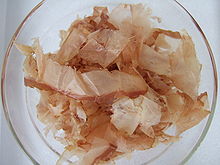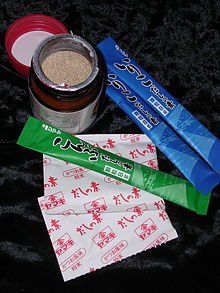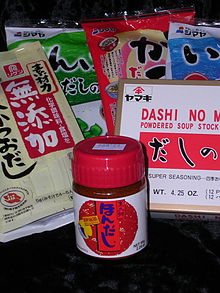- Dashi
-
For other uses, see Dasi (disambiguation).
Dashi (出汁, だし) is a class of soup and cooking stock, considered fundamental to Japanese cooking. In 1980, Shizuo Tsuji wrote:
"Many substitutes for dashi are possible, but without dashi, dishes are merely à la japonaise and lack the authentic flavor."[1]
Dashi forms the base for miso soup, clear broth, noodle broth, and many kinds of simmering liquid.
Contents
Types
The most common form of dashi is a simple broth or stock made by heating water containing kombu (edible kelp) and kezurikatsuo (shavings of katsuobushi - preserved, fermented tuna) to near-boiling, then straining the resultant liquid.
Fresh dashi, made from dried kelp and katsuobushi, is rare today, even in Japan.[2] Most people now use granulated or liquid instant substitutes.
Other kinds of dashi stock are made by soaking kelp, niboshi, or shiitake in water for many hours or by heating them in near-boiling water and straining the resulting broth.
- Kombu dashi stock is made by soaking kelp in water.
- Niboshi dashi stock is made by pinching off the heads and entrails of small dried sardines, to prevent bitterness, and soaking the remains in water.
- Shiitake dashi stock is made by soaking dried shiitake mushrooms in water.
History
In 1908, the unusual and strong flavor of kelp dashi was identified by Kikunae Ikeda as umami, the "fifth flavor", attributed to human taste receptors responding to glutamic acid.[3]
References
- ^ Tsuji, Shizuo (1980). Japanese Cooking: A Simple Art. New York: Kodansha International. p. 147. ISBN 0870113992.
- ^ Ingredients used for making dashi at home cooking (Japanese).
- ^ Lindemann, Bernd; Ogiwara, Yoko; Ninomiya, Yuzo. "The Discovery of Umami". Oxford Journals. http://chemse.oxfordjournals.org/content/27/9/843.full.
Additional reading
- Hosking, Richard (1995). A Dictionary of Japanese Food. Tuttle. ISBN 0-8048-2042-2.
Categories:- Japanese condiments
- Umami enhancers
Wikimedia Foundation. 2010.



